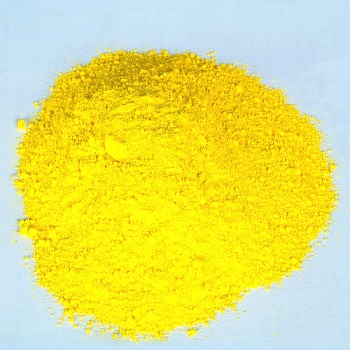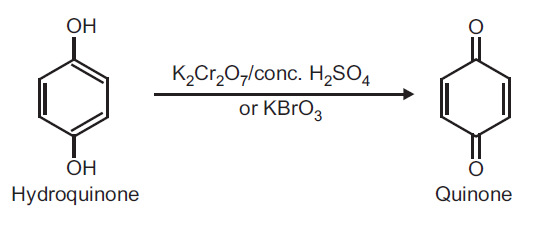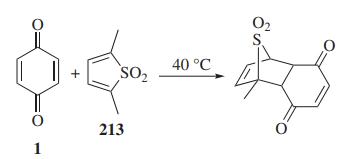1,4-ベンゾキノン 化学特性,用途語,生産方法
外観
うすい黄色~くすんだ黄色~暗い緑色粉末~結晶
外観
うすい黄色~黄色~黄赤色粉末~結晶
解説
1,4-ベンゾキノン,芳香烃苯核中的两个氢原子被两个氧原子取代而形成双键的化合物的总称。 苯醌、萘醌、蒽醌等 狭义上是指对苯醌。 它通常是有色的,并表现出浓硫酸和碱特有的美丽的颜色反应。 容易减少。 许多衍生物作为合成染料很重要,其中许多是天然的动植物颜料。
森北出版「化学辞典(第2版)
用途
重合防止剤、酸化剤、写真用薬剤、染料原料、皮革のなめし
製法
相当するp-およびo-ジヒドロキシ芳香族化合物(ヒドロキノン)、アミノフェノール、芳香族ジアミンを酸化すると得られる。ジヒドロキシ芳香族化合物の酸化によりキノンを生成する反応は可逆反応であり、還元によりキノンは元のジヒドロキシ化合物(ヒドロキノン)に戻る。
説明
Quinone (p-benzoquinone) exists as a large yellow, monoclinic prism with an irritating
odour resembling that of chlorine. Quinone is extensively used as a chemical intermediate,
a polymerisation inhibitor, an oxidising agent, a photographic chemical, a tanning
agent, and a chemical reagent. Quinone (p-benzoquinone) was first produced commercially
in 1919 and has since been manufactured in several European countries. Its major
use is in hydroquinone production, but it is also used as a polymerisation inhibitor and
as an intermediate in the production of a variety of substances, including rubber accelerators
and oxidising agents. It is used in the dye, textile, chemical, tanning, and cosmetic
industries. In chemical synthesis for hydroquinone and other chemicals, quinone is used
as an intermediate. It is also used in the manufacturing industries and chemical laboratory
associated with protein fibre, photographic film, hydrogen peroxide, and gelatin making.
Occupational exposure to quinone may occur in the dye, textile, chemical, tanning, and
cosmetic industries. Inhalation exposure to quinone may occur from tobacco smoke.
化学的特性
Quinone is a yellow, crystalline material or large yellow, monoclinic prisms. Pungent, irritating odor.

1,4-Benzoquinone or p-benzoquinone is the basic structure of quinonoid compounds.They are widely distributed in the natural world, being found in bacteria, plants and arthropods and hence quinones are ubiquitous to living systems. Quinones play pivotal role in biological functions including oxidative phosphorylation and electron transfer.
物理的性質
Light yellow crystals with an acrid odor resembling chlorine. Odor threshold concentration is 84
ppb (quoted, Amoore and Hautala, 1983).
使用
1,4-Benzoquinone is used in the manufacture of dyes, fungicide, and hydroquinone; for tanning hides; as an oxidizing agent; in photography; making gelatin insoluble; strengthening animal fibers and as reagent.
定義
ChEBI: 1,4-benzoquinone is the simplest member of the class of 1,4-benzoquinones, obtained by the formal oxidation of hydroquinone to the corresponding diketone. It is a metabolite of benzene. It has a role as a cofactor, a human xenobiotic metabolite and a mouse metabolite.
主な応用
p-Benzoquinone is used as a dienophile in Diels-Alder cycloadditions to prepare naphthoquinones and 1,4-phenanthrenediones. It acts as a dehydrogenation reagent and an oxidizer in synthetic organic chemistry. In the Thiele-Winter reaction, it is involved in the preparation of triacetate of hydroxyquinol by reacting with acetic anhydride and sulfuric acid. It is also used in the synthesis of bromadol and to suppress double- bond migration during olefin metathesis reactions. It is used as a precursor to hydroquinone which finds application in photography and as a reducing agent and an antioxidant in rubber production.
調製方法
Quinone was produced as early as 1838 by oxidation of quinic acid with manganese dioxide. Quinone can be prepared by oxidation starting with aniline or by the oxidation of hydroquinone with bromic acid. More recently, quinone has been made biosynthetically from D-glucose.
製造方法
Preparation of Quinone (p-Benzoquinone) from Hydroquinone.
Principle: Hydroquinone can be readily oxidized to quinone by using oxidizing agent like potassium dichromate and conc. H2SO4 or KBrO3.
Reaction:

Procedure: Take 0.5 g hydroquinone and 5 ml distilled water in a beaker (25 ml). Heat on a wire gauze to obtain a clear solution. Take 1 g potassium dichromate (K2Cr2O7) in a conical flask and dissolve in 10 ml water and add 1 ml conc. H2SO4. Shake and cool the conical flask in ice water. To this ice cold solution add hydroquinone solution (prepared above) dropwise over a period of 30 minutes with constant shaking. Do not allow the temperature to rise above 20oC. After complete addition, continue shaking for further 10 minutes. Yellow crystals of quinone separate out. Filter on a Buchner funnel and dry it well. (Note: Do not wash with water as the product is water soluble). Record the practical yield and re-crystallize from ethyl alcohol.
Re-crystallization: Dissolve the crude product in minimum amount of ethyl alcohol in a beaker by heating on a water bath. Filter the hot solution and cool the filtrate. The yellow needles of quinone separate out. Filter, dry and record the melting point and TLC (using toluene as a solvent).
反応性
1,4-Benzoquinone and its derivatives are extensively used in Diels-Alder reactions. A facile tautomerization of alkyl substituted 1,4-benzoquinone to o-quinone methide is the highlight of this cycloaddition.

Diels-Alder reaction of 1,4-benzoquinone with thiophene dioxide by Kang et al.
一般的な説明
Benzoquinone appears as a yellowish-colored crystalline solid with a pungent, irritating odor. Poisonous by ingestion or inhalation of vapors. May severely damage skin, eyes and mucous membranes. Used to make dyes and as a photographic chemical.
空気と水の反応
Soluble in water and denser than water. If moist 1,4-Benzoquinone may decompose spontaneously above 140°F. This has occurred in drums, causing over-pressurization.
反応プロフィール
1,4-Benzoquinone acts as an oxidizing agent .
危険性
Toxic by inhalation, strong irritant to skin,
eyes and mucous membranes. Skin damage. Ques-
tionable carcinogen.
健康ハザード
1,4-Benzoquinone is moderately toxic viaingestion and skin contact. It is a mutagen andmay cause cancer. Because of its low vaporpressure, 0.1 torr (at 25°C 77°F), the healthhazard due to inhalation of its vapor is low.However, prolonged exposure may produceeye irritation, and its contact with the eyes can injure the cornea. Contact with the skincan lead to irritation, ulceration, and necrosis.
The toxicity of benzoquinone is similarto that of hydroquinone and benzenetriol.Repeated intraperitoneal administration of2 mg/kg/day to rats for 6 weeks produced significantdecreases in red blood cell, bone marrowcounts, and hemoglobin content (Raoet al. 1988). In addition, relative changes inorgan weights and injuries to the liver, thymus,kidney, and spleen were observed. Lauet al. (1988) investigated the correlation oftoxicity with increased glutathione substitutionin 1,4-benzoquinone. With the exceptionof the fully substituted isomer, increased substitutionresulted in enhanced nephrotoxicity.Although the conjugates were more stable tooxidation, the toxicity increased. The oral andintravenous toxicities of this compound in ratsare as follow:
LD50 value, oral (rats): 130 mg/kg
LD50 value, intravenous (rats): 25 mg/kg
The carcinogenicity of 1,4-benzoquinone inhumans is not reported. However, it is amutagen. It produced tumors in the lungs andskin of mice.
火災危険
Noncombustible solid; ignition can occur
after only moderate heating, autoignition
temperature 560°C (1040°F); fire-extinguishing
agent: water spray. 1,4-Benzoquinone
may react violently with strong oxidizers,
especially at elevated temperatures.
安全性プロファイル
Poison by ingestion, subcutaneous, intraperitoneal, and intravenous routes. Questionable carcinogen with experimental tumorigenic data by skin contact. Human mutation data reported. Quinone has a characteristic, irritating odor. Causes severe damage to the skin and mucous membranes by contact with it in the solid state, in solution, or in the form of condensed vapors. Locally, it causes dlscoloration, severe irritation, erythema, swehng, and the formation of papules and vesicles, whereas prolonged contact may lead to necrosis. When the eyes become involved, it causes dangerous disturbances of vision. The moist material self-heats and decomposes exothermically above 60℃. When heated to decomposition it emits acrid smoke and fumes.
職業ばく露
Due to this compound’s ability to
react with certain nitrogen compounds to form colored sub-
stances, quinone is widely used in the dye, textile, chemi-
cal, tanning, and cosmetic industries. It is used as an
industrial chemical; laboratory reagent; and as an interme-
diate in chemical synthesis for hydroquinone and other
chemicals.
発がん性
Quinone has been tested for
carcinogenicity in mice by skin application or inhalation
and in rats by subcutaneous injection. None of these
studies were considered sufficient to evaluate carcinogenicity
(335, 336). A cancer bioassay of Tribolium-infested flour
has been conducted but lack of quantification of quinone
and methodological issues make the data difficult to
interpret.
Quinone has produced negative results in studies designed
to examine its ability to promote carcinogenicity. In a liver
bioassay, quinone did not increase the formation of GGTpositive
foci in the liver. Quinone did not promote
induction of stomach or skin tumors in mice dosed with 7,12-
dimethylbenzanthracene.
環境運命予測
Quinone exists in the atmosphere in the gas phase. The
dominant atmospheric loss process for quinone is expected to
be by reaction with the hydroxyl (OH) radical (reaction with
ozone is expected to be slow because of the >C(O) substituent
groups). The estimated half-life and lifetime of quinone in the atmosphere due to reaction with the OH radical are w3 and
4 h, respectively. Release of 1,4-benzoquinone to the environment
occurs via its effluents during its commercial
production and use and in wastewaters from the coal industry.
If released to soil, it is likely to leach (estimated Koc of 30) and
may volatilize and photodegrade on soil surfaces. The ambient
atmospheric concentration of 1,4-benzoquinone has been reported
to be less than 15–80 ng m
-3, and benzoquinone has
been detected in tobacco smoke.
輸送方法
UN2587 Benzoquinone, Hazard Class: 6.1;
Labels: 6.1-Poisonous materials.
純化方法
Purify p-benzoquinone in one or more of the following ways: steam distillation followed by filtration and drying (e.g. in a desiccator over CaCl2), crystallisation from pet ether (b 80-100o), *benzene (with, then without, charcoal), water or 95% EtOH, sublimation under vacuum (e.g. from room temperature to liquid N2). It slowly decomposes and should be stored, refrigerated, in an evacuated or sealed glass vessel in the dark. It should be resublimed before use. [Wolfenden et al. J Am Chem Soc 109 463 1987, Beilstein 7 IV 2065.]
不和合性
Incompatible with oxidizers (chlorates,
nitrates, peroxides, permanganates, perchlorates, chlorine,
bromine, fluorine, etc.); contact may cause fires or explo-
sions. Keep away from alkaline materials, strong bases, strong
acids, oxoacids, epoxides, some combustible substances;
reducing agents. Decomposes exothermically on warming
above 60 ? C, when moist, producing carbon monoxide.
廃棄物の処理
Controlled incineration
(982℃, 2.0 seconds minimum).
1,4-ベンゾキノン 上流と下流の製品情報
原材料
準備製品